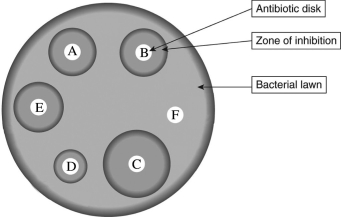Scenario
In order to test the susceptibility of bacteria (if the bacteria are susceptible to being killed) to an antibiotic, a common laboratory test called the Bauer-Kirby Disk Diffusion test is used. First, a petri dish (a shallow, circular, transparent dish with a flat lid) is partially filled with nutrient-enriched agar (a gelatinous material) . The nutrients encourage growth of specific bacterial species. The agar is poured as liquid but then typically solidifies to a soft consistency. Once the agar is set, a "lawn" of bacteria is spread such that a thin layer covers the top of the agar. Antibiotics are then applied to the lawn in a small dose, often through small, saturated paper disks. The dish is typically incubated for 24-48 hours and then observed for susceptibility. If the antibiotic is effective, it will kill the bacteria and leave a clear area called the "zone of inhibition" due to inhibited bacterial growth. The area starts at the source of the antibiotic and radiates outward. Scientists measure the diameter of the zone and then compare it to an established "cutoff value" for a zone specific to antibiotic/organism combinations. A large zone of inhibition in comparison to the standard indicates susceptibility while a small or no zone indicates resistance. Consider the following image, and answer the questions that follow: 
-What can you conclude about the susceptibility of the bacteria to the antibiotics?
Definitions:
Awake But Relaxed State
A state of consciousness characterized by being alert yet physically and mentally relaxed, often associated with meditation or light hypnosis.
Suprachiasmatic Nucleus
A tiny region in the brain's hypothalamus responsible for controlling circadian rhythms, or the body's internal clock.
Retinal Proteins
Molecules within the retina that are essential for the conversion of light into visual signals.
Circadian Rhythm
The natural, internal process that regulates the sleep-wake cycle and repeats roughly every 24 hours.
Q2: Of these steps, which occurs first in
Q13: Stripping is not considered to be a
Q18: Research on university students supports the connection
Q21: The biological species concept cannot be applied
Q25: With regard to child sexual abuse in
Q42: A father who abuses his preschool child
Q46: Describe the three forms of incest listed
Q46: When most populations of a wide-ranging amphibian
Q48: In the vast majority of sexual abuse
Q53: What percentage of Canadians believes that adults